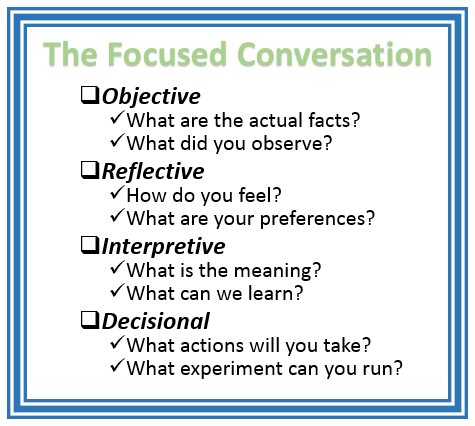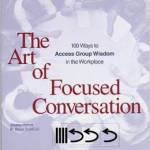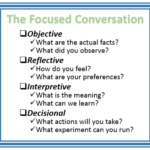I was presenting Building Antifragile Relationships and Teams at Santa Barbara Agile recently and as we worked on ideas for a conflict protocol, we started discussing the common theme of “facts vs. feelings”. I’ll point out that there was not a hard-line view in the group as to one way or another, but it came up and opened up a nice discussion on the topic.

I mentioned The Focused Conversation as a great tool you can use to help structure a conversation. Focused Conversations include four important categories of questions — objective, reflective, interpretive, and decision focused questions. The acronym ORID is sometimes used to describe The Focused Conversation.
The structure also provides a way to hear all of the voices that need to be heard within the group or team. You might even use this as part of an agile retrospective. Using the tool is another way to build antifragile relationships in teams and organizations.
The Focused Conversation
Objective questions focus on facts and data. These are the “facts” that no one disagrees with. Examples of these might be the raw data that you have, what was said, where or when things happened, etc. Clearly, there are situations where people can’t agree on the facts. If people can’t agree on a fact, then it probably fits in to one of the categories below. The idea here is to make sure that everyone is on the same page with at least what they agree on. This can often be surprising, since in many cases I find that people expect everyone is on the same page with the facts — and they are not.
Realize right off the bat that as a facilitator, people are going to want to jump down the stack to reflective and interpretive questions — or even decisions. Expect that, and be sure to let everyone know before you start, when you explain the structure for the conversation. Tell them that you will bring them back to objective questions (or the category of question at hand) as the need arises. You will find that if put up a “poster” in a location where everyone in the room can see the four types of questions, many people will start self-adjusting to stick to the type of question you are on.
Reflective questions focus on feelings and reactions. These may be based on past situations or memories and are intended to get these feeling on the table. My experience over the years is that these questions are typically the ones that get the least air-play. There are a number of problems with ignoring reflective questions. One issue that is that people process information differently. Some may be very focused on data and others on feelings — and both are important. You are likely reading this and thinking about someone you know that is more focused on one of the two. That person might be you. If it is you, realize that about yourself and you can then work on seeing more value in the other category of questions. Being able to value both objective and reflective (and even interpretive) types of questions gives you more depth as a person, regardless of what role you are in. These questions certainly work in our personal life as well as our work life!
Interpretive questions focus on meaning. What is important? What does it mean? What are the implications for us? These types of questions are often where people want to start, I know I often do! Now that we have already answered the objective and reflective questions, we can dig into these!
Decision based questions get to an end point. What is the response we will take? What decision will be made? We may ask what the next steps are if a “final” decision is not possible. Maybe we need to take a few steps, learn, and revisit the issue. This is another place we often like to jump before understanding the facts, assessing how this made us feel, or interpreting the meaning. 
You can design conversations in advance based on the topic and goals for the conversation or you can use ORID as a way to focus any conversation. I like to put the four categories of questions up on a flip chart or white board as a visual reminder (the poster I mentioned) — virtual meetings and teams can do the same using a virtual board.
You can read much more about The Focused Conversation, including sample questions for a wide variety of conversions in the book The Art of The Focused Conversation edited by Brian Stanfield. The Focused Conversation was developed by the Institute of Cultural Affairs Canada. Trying to do the book justice in a short article is tough! I would recommend buying the book. The book covers preparing & leading conversations as well as dealing with typical mistakes. There is also a whitepaper written by Brian, which gets into more details, and starts off this excellent quote:
Once a society loses this capacity [to dialogue], all that is left is a cacophony of voices battling it out to see who wins and who loses. There is no capacity to go deeper, to find a deeper meaning that transcends individual views and self interest. It seems reasonable to ask whether many of our deeper problems in governing ourselves today, the so-called “gridlock” and loss of mutual respect and caring might not stem from this lost capacity to talk with one another, to think together as part of a larger community.” — Peter M. Senge, in “A New View of Institutional Leadership” in Reflections on Leadership
All Four Add Value
You don’t have to spend an hour on each category of question, but ignoring facts to jump to a decision or devaluing reflective questions because you just want to talk about data will not necessarily get you better results. In fact, it may do just the opposite, especially in the longer term! Anytime we focus on only one category of question we tend to run into problems.
Remember that all four categories of questions add value!
People have different focal points and for specific situations, with each person potentially wanting to discuss the topic from a different starting point. To some, the data might be the most important, for others having an opportunity to reflect on the situation and state how they feel about it is critical. Others may find that interpreting the situation is where they want to start and of course some may just want to take action and make a decision.
Consider a time when you were in a meeting where everyone was frustrated? Would this have helped? It is hard to tell without a time machine, but you might give this a shot in your next meeting!









Jake, I like this framework and the idea of taking them step by step. As always, your outlines make it easy to understand the process, the challenges, the objections people will likely raise, and the improved outcomes that will result. Great!